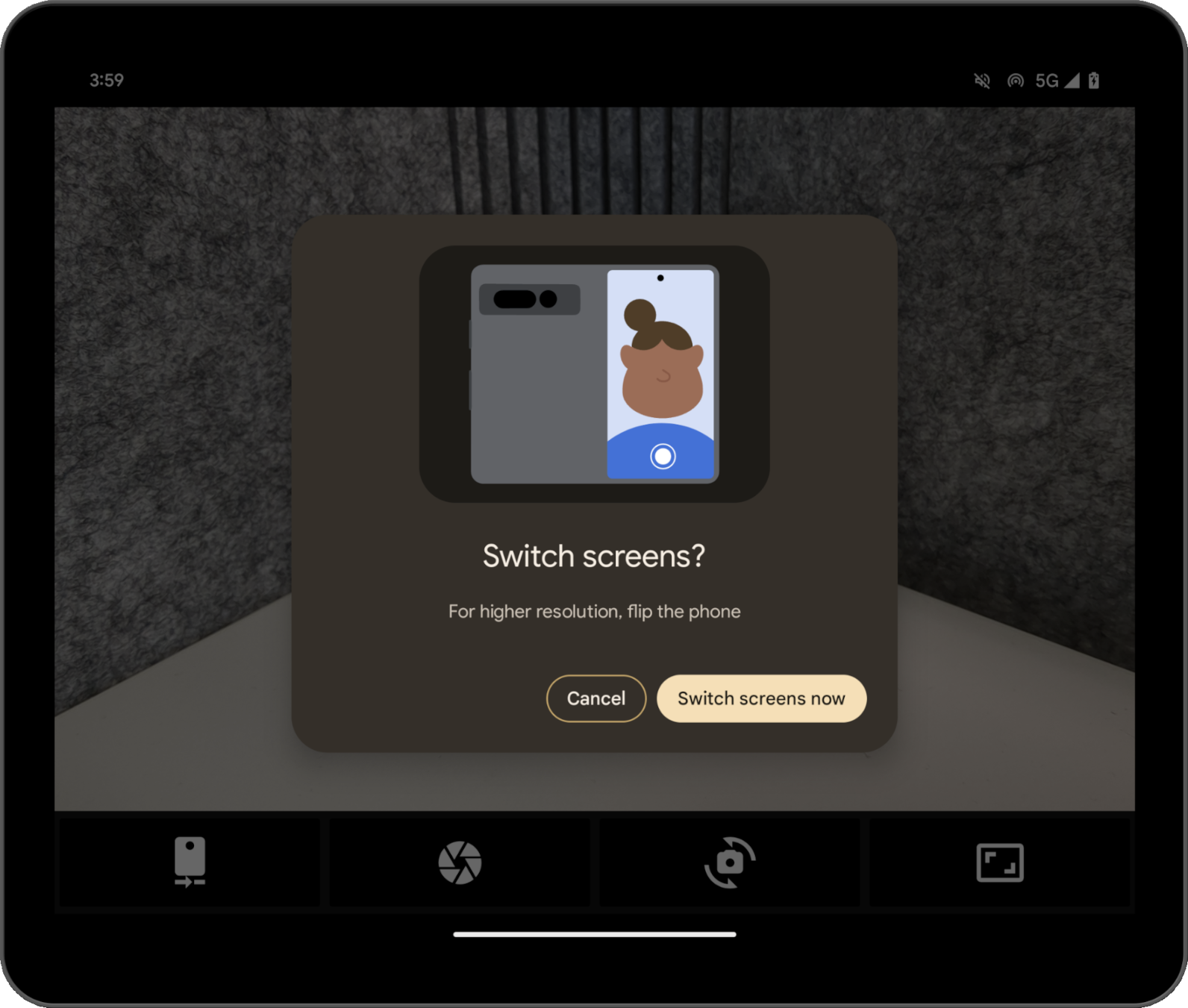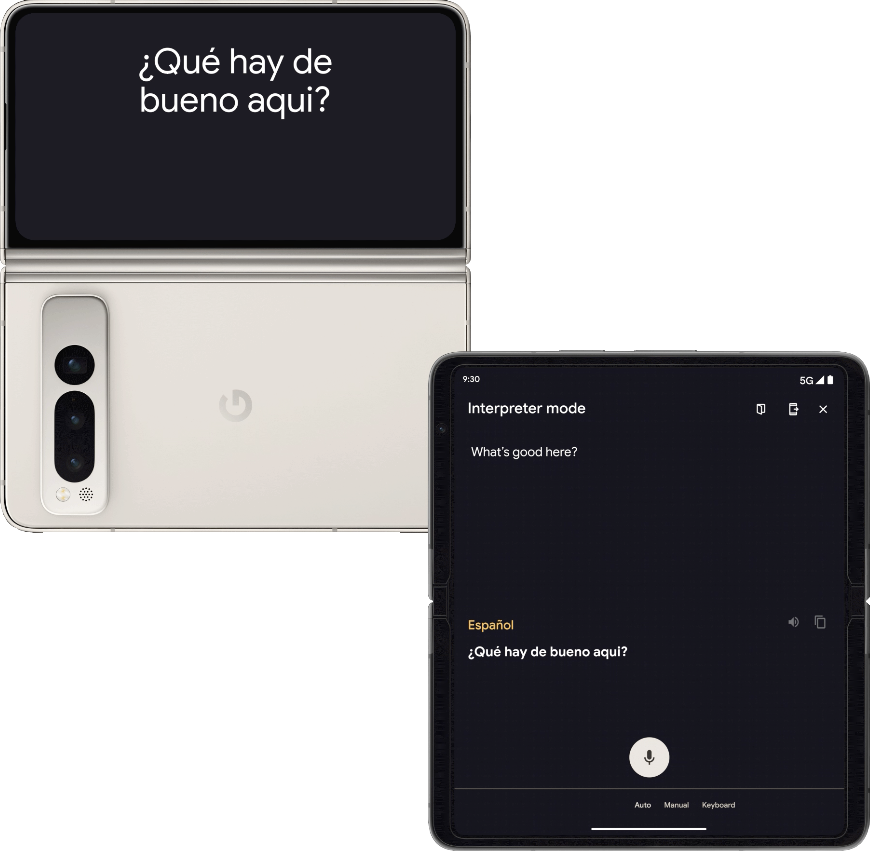折叠式设备提供独特的观看体验。后置显示模式和双屏模式使您可以为折叠式设备构建特殊的显示功能,例如后置摄像头自拍预览以及内外屏幕上同时显示不同内容。
后置显示模式
通常情况下,当折叠式设备展开时,只有内屏处于活动状态。后置显示模式允许您将活动移至折叠式设备的外屏,该外屏在设备展开时通常背对用户。内屏会自动关闭。
一个新颖的应用是在外屏显示相机预览,这样用户就可以使用后置摄像头自拍,后置摄像头通常比前置摄像头具有更好的拍照性能。
要激活后置显示模式,用户需要响应对话框以允许应用切换屏幕,例如

系统会创建对话框,因此您无需进行任何开发。根据设备状态显示不同的对话框;例如,如果设备关闭,系统会指示用户展开设备。您无法自定义对话框,并且它在不同 OEM 的设备上可能会有所不同。
您可以使用 Pixel Fold 相机应用试用后置显示模式。请在 codelab 中查看示例实现 使用 Jetpack WindowManager 优化您在折叠式设备上的相机应用。
双屏模式
双屏模式允许您同时在折叠式设备的两个显示屏上显示内容。双屏模式适用于运行 Android 14(API 级别 34)或更高版本的 Pixel Fold。
一个用例示例是双屏翻译器。

以编程方式启用模式
您可以通过 Jetpack WindowManager API 访问后置显示模式和双屏模式,从库版本 1.2.0-beta03 开始。
将 WindowManager 依赖项添加到您的应用模块 build.gradle 文件
Groovy
dependencies { implementation "androidx.window:window:1.2.0-beta03" }
Kotlin
dependencies { implementation("androidx.window:window:1.2.0-beta03") }
入口点是 WindowAreaController,它提供与在显示屏之间或设备上的显示区域之间移动窗口相关的的信息和行为。WindowAreaController 允许您查询可用 WindowAreaInfo 对象的列表。
使用 WindowAreaInfo 访问 WindowAreaSession,这是一个表示活动窗口区域功能的接口。使用 WindowAreaSession 确定特定 WindowAreaCapability 的可用性。
每个功能都与特定的 WindowAreaCapability.Operation 相关。在 1.2.0-beta03 版本中,Jetpack WindowManager 支持两种操作
WindowAreaCapability.Operation.OPERATION_PRESENT_ON_AREA,用于启动双屏模式WindowAreaCapability.Operation.OPERATION_TRANSFER_ACTIVITY_TO_AREA,用于启动后置显示模式
以下是如何在应用的主活动中声明后置显示模式和双屏模式变量的示例
Kotlin
private lateinit var windowAreaController: WindowAreaController private lateinit var displayExecutor: Executor private var windowAreaSession: WindowAreaSession? = null private var windowAreaInfo: WindowAreaInfo? = null private var capabilityStatus: WindowAreaCapability.Status = WindowAreaCapability.Status.WINDOW_AREA_STATUS_UNSUPPORTED private val dualScreenOperation = WindowAreaCapability.Operation.OPERATION_PRESENT_ON_AREA private val rearDisplayOperation = WindowAreaCapability.Operation.OPERATION_TRANSFER_ACTIVITY_TO_AREA
Java
private WindowAreaControllerCallbackAdapter windowAreaController = null; private Executor displayExecutor = null; private WindowAreaSessionPresenter windowAreaSession = null; private WindowAreaInfo windowAreaInfo = null; private WindowAreaCapability.Status capabilityStatus = WindowAreaCapability.Status.WINDOW_AREA_STATUS_UNSUPPORTED; private WindowAreaCapability.Operation dualScreenOperation = WindowAreaCapability.Operation.OPERATION_PRESENT_ON_AREA; private WindowAreaCapability.Operation rearDisplayOperation = WindowAreaCapability.Operation.OPERATION_TRANSFER_ACTIVITY_TO_AREA;
以下是如何在活动的 onCreate() 方法中初始化变量
Kotlin
displayExecutor = ContextCompat.getMainExecutor(this) windowAreaController = WindowAreaController.getOrCreate() lifecycleScope.launch(Dispatchers.Main) { lifecycle.repeatOnLifecycle(Lifecycle.State.STARTED) { windowAreaController.windowAreaInfos .map { info -> info.firstOrNull { it.type == WindowAreaInfo.Type.TYPE_REAR_FACING } } .onEach { info -> windowAreaInfo = info } .map { it?.getCapability(operation)?.status ?: WindowAreaCapability.Status.WINDOW_AREA_STATUS_UNSUPPORTED } .distinctUntilChanged() .collect { capabilityStatus = it } } }
Java
displayExecutor = ContextCompat.getMainExecutor(this); windowAreaController = new WindowAreaControllerCallbackAdapter(WindowAreaController.getOrCreate()); windowAreaController.addWindowAreaInfoListListener(displayExecutor, this); windowAreaController.addWindowAreaInfoListListener(displayExecutor, windowAreaInfos -> { for(WindowAreaInfo newInfo : windowAreaInfos){ if(newInfo.getType().equals(WindowAreaInfo.Type.TYPE_REAR_FACING)){ windowAreaInfo = newInfo; capabilityStatus = newInfo.getCapability(presentOperation).getStatus(); break; } } });
在开始操作之前,请检查特定功能的可用性
Kotlin
when (capabilityStatus) { WindowAreaCapability.Status.WINDOW_AREA_STATUS_UNSUPPORTED -> { // The selected display mode is not supported on this device. } WindowAreaCapability.Status.WINDOW_AREA_STATUS_UNAVAILABLE -> { // The selected display mode is not available. } WindowAreaCapability.Status.WINDOW_AREA_STATUS_AVAILABLE -> { // The selected display mode is available and can be enabled. } WindowAreaCapability.Status.WINDOW_AREA_STATUS_ACTIVE -> { // The selected display mode is already active. } else -> { // The selected display mode status is unknown. } }
Java
if (capabilityStatus.equals(WindowAreaCapability.Status.WINDOW_AREA_STATUS_UNSUPPORTED)) { // The selected display mode is not supported on this device. } else if (capabilityStatus.equals(WindowAreaCapability.Status.WINDOW_AREA_STATUS_UNAVAILABLE)) { // The selected display mode is not available. } else if (capabilityStatus.equals(WindowAreaCapability.Status.WINDOW_AREA_STATUS_AVAILABLE)) { // The selected display mode is available and can be enabled. } else if (capabilityStatus.equals(WindowAreaCapability.Status.WINDOW_AREA_STATUS_ACTIVE)) { // The selected display mode is already active. } else { // The selected display mode status is unknown. }
双屏模式
以下示例在功能已激活的情况下关闭会话,否则调用 presentContentOnWindowArea() 函数
Kotlin
fun toggleDualScreenMode() { if (windowAreaSession != null) { windowAreaSession?.close() } else { windowAreaInfo?.token?.let { token -> windowAreaController.presentContentOnWindowArea( token = token, activity = this, executor = displayExecutor, windowAreaPresentationSessionCallback = this ) } } }
Java
private void toggleDualScreenMode() { if(windowAreaSession != null) { windowAreaSession.close(); } else { Binder token = windowAreaInfo.getToken(); windowAreaController.presentContentOnWindowArea( token, this, displayExecutor, this); } }
请注意,应用的主活动用作 WindowAreaPresentationSessionCallback 参数。
API 使用侦听器方法:当您请求将内容呈现到可折叠设备的另一个显示屏时,您将启动一个会话,该会话将通过侦听器的 onSessionStarted() 方法返回。当您关闭会话时,您会在 onSessionEnded() 方法中收到确认。
要创建侦听器,请实现 WindowAreaPresentationSessionCallback 接口
Kotlin
class MainActivity : AppCompatActivity(), windowAreaPresentationSessionCallback
Java
public class MainActivity extends AppCompatActivity implements WindowAreaPresentationSessionCallback
侦听器需要实现 onSessionStarted()、onSessionEnded() 和 onContainerVisibilityChanged() 方法。回调方法会通知您会话状态,并使您可以相应地更新应用。
onSessionStarted() 回调接收 WindowAreaSessionPresenter 作为参数。该参数是允许您访问窗口区域并显示内容的容器。当用户离开主应用程序窗口时,系统可以自动关闭演示文稿,也可以通过调用 WindowAreaSessionPresenter#close() 关闭演示文稿。
对于其他回调,为简单起见,只需在函数体中检查任何错误,并记录状态即可
Kotlin
override fun onSessionStarted(session: WindowAreaSessionPresenter) { windowAreaSession = session val view = TextView(session.context) view.text = "Hello world!" session.setContentView(view) } override fun onSessionEnded(t: Throwable?) { if(t != null) { Log.e(logTag, "Something was broken: ${t.message}") } } override fun onContainerVisibilityChanged(isVisible: Boolean) { Log.d(logTag, "onContainerVisibilityChanged. isVisible = $isVisible") }
Java
@Override public void onSessionStarted(@NonNull WindowAreaSessionPresenter session) { windowAreaSession = session; TextView view = new TextView(session.getContext()); view.setText("Hello world, from the other screen!"); session.setContentView(view); } @Override public void onSessionEnded(@Nullable Throwable t) { if(t != null) { Log.e(logTag, "Something was broken: ${t.message}"); } } @Override public void onContainerVisibilityChanged(boolean isVisible) { Log.d(logTag, "onContainerVisibilityChanged. isVisible = " + isVisible); }
为了保持整个生态系统的连贯性,请使用 双屏官方图标 来指示用户如何启用或禁用双屏模式。
有关可运行的示例,请参阅 DualScreenActivity.kt。
后置显示模式
与双屏模式示例类似,以下 toggleRearDisplayMode() 函数的示例在功能已激活的情况下关闭会话,否则调用 transferActivityToWindowArea() 函数
Kotlin
fun toggleRearDisplayMode() { if(capabilityStatus == WindowAreaCapability.Status.WINDOW_AREA_STATUS_ACTIVE) { if(windowAreaSession == null) { windowAreaSession = windowAreaInfo?.getActiveSession( operation ) } windowAreaSession?.close() } else { windowAreaInfo?.token?.let { token -> windowAreaController.transferActivityToWindowArea( token = token, activity = this, executor = displayExecutor, windowAreaSessionCallback = this ) } } }
Java
void toggleDualScreenMode() { if(capabilityStatus == WindowAreaCapability.Status.WINDOW_AREA_STATUS_ACTIVE) { if(windowAreaSession == null) { windowAreaSession = windowAreaInfo.getActiveSession( operation ) } windowAreaSession.close() } else { Binder token = windowAreaInfo.getToken(); windowAreaController.transferActivityToWindowArea(token, this, displayExecutor, this); } }
在这种情况下,显示的活动用作 WindowAreaSessionCallback,它更易于实现,因为回调不会接收允许在窗口区域显示内容的演示者,而是将整个活动转移到另一个区域
Kotlin
override fun onSessionStarted() { Log.d(logTag, "onSessionStarted") } override fun onSessionEnded(t: Throwable?) { if(t != null) { Log.e(logTag, "Something was broken: ${t.message}") } }
Java
@Override public void onSessionStarted(){ Log.d(logTag, "onSessionStarted"); } @Override public void onSessionEnded(@Nullable Throwable t) { if(t != null) { Log.e(logTag, "Something was broken: ${t.message}"); } }
为了保持整个生态系统的连贯性,请使用 后置摄像头官方图标 来指示用户如何启用或禁用后置显示模式。
其他资源
- 使用 Jetpack WindowManager 优化您在折叠式设备上的相机应用 codelab
androidx.window.area包摘要- Jetpack WindowManager 示例代码
